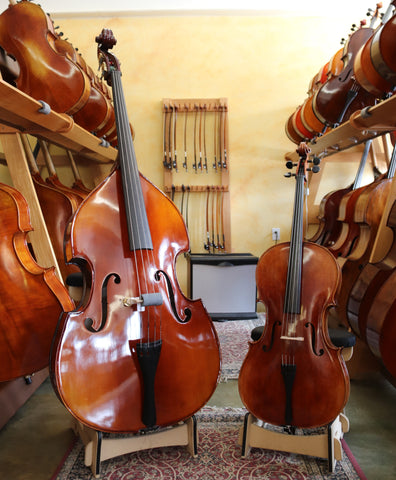The Story of the Bass and Cello
This is the (mostly fictitious) story of a man named Silvestro. Silvestro was an Italian musician who wrote songs and technique books.
One day, in the early 1500s, Silvestro said to himself, “Ah! I need to hit the low notes, but the violin and viola cannot go low enough.” This was quite the pickle to be in, and Silvestro knew it. So, Silvestro did the best he could to fix the problem and thought of a solution. “What if...” he thought, “I make a new instrument, one that is capable of going low enough for the lower notes?” Then, it hit him like a horse (trucks hadn’t been invented yet): The Double Bass. “It’s perfect!” Silvestro cried, and he got to work on it right away.
The double bass is very similar to the violin or viola, only it’s a lot bigger and can therefore produce much lower notes than the violin or viola. Standing at about the size of a person, this new instrument provided just the support needed to make his music full, and Silvestro knew this. He utilized the double bass, and so did many composers.
The double bass quickly caught on with all the musical folks all over the place, and became quite popular. However, there were people who felt like they needed more. The double bass was too low, and reaching a nice middle ground in terms of pitch was much too difficult for the average bassist. So, people did some more innovation and development.

One day, in the mid-1500s, Andreas noticed how the double bass almost seemed to be missing something. Some other piece of the puzzle just wasn’t quite there. So he gave it lots of thought and the idea hits him like a horse! “The cello!” he exclaimed, “it could be half the size of a bass, and would have a pitch range higher than that of a double bass. Yes, this would be a great accompaniment to the bass!” So, Andreas did what he had to, and made the cello. Similar to bass, it was larger than the violin and viola, but not quite as much of a difference was present as was between the violin and the bass. The cello was only about the size of an eight-year-old, but can hit higher notes. The strings were tuned differently too.
Like its predecessor the bass, the cello quickly became a string instrument staple, and it became difficult to imagine a world without the cello. Nowadays, every full orchestra has got themselves a cello and a bass section to give the music life.


Want to see and hear the differences in person? Come by our shop, we would be more than happy to show you!
